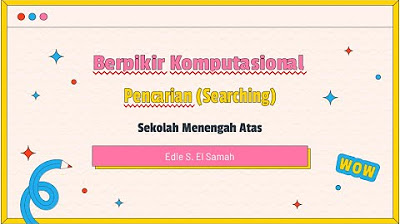Berpikir Komputasional dan Algoritma Pemrograman - Berpikir Komputasional - Informatika Kelas XII
Summary
TLDRThis video introduces students to computational thinking and programming algorithms. It emphasizes the importance of breaking down complex problems into smaller, manageable parts and applying logical strategies to find efficient solutions. The lesson encourages students to explore computational thinking in everyday problem-solving, such as using technology for tasks like online marketing or solving mathematical equations. It also highlights the key components of computational thinking: decomposition, pattern recognition, abstraction, and algorithms, while urging students to collaborate and apply these concepts practically. Overall, it promotes creative, structured thinking to solve complex issues.
Takeaways
- 😀 Welcoming message with good wishes for students' health and well-being, along with prayers for those who are sick.
- 💻 Introduction to computational thinking and programming algorithms, aiming to help students understand problem-solving strategies and algorithmic approaches.
- 🔍 Focus on modular programming, basic processes, and creating efficient algorithms for various applications.
- 🤖 Introduction to the concept of computational thinking, which combines logical, mathematical, and technical problem-solving approaches.
- 🧩 Key computational thinking skills include decomposition, pattern recognition, abstraction, and algorithm development.
- 👨💻 Examples are provided of using computational thinking in everyday scenarios, such as solving math, physics, and chemistry problems.
- 🌐 Emphasis on the role of technology in daily life and the importance of staying updated with technological advancements.
- 🧠 Computational thinking is also about enhancing creativity and analytical skills to address complex problems.
- 📊 Discussion activities encourage students to work in groups to understand computational thinking concepts and create presentations.
- 📈 Computational thinking is useful for modern problem-solving, including online product marketing and other digital activities.
Q & A
What is the main topic discussed in the video?
-The main topic of the video is computational thinking and programming algorithms, with a focus on how students can apply computational thinking to solve real-world problems.
What are students expected to learn from this lesson?
-Students are expected to understand and analyze problems using algorithmic strategies, choose optimal and efficient solutions, understand modular programming, write programs using procedures or functions, and learn about standard algorithms, including those related to artificial intelligence.
What is computational thinking, and how is it defined in the video?
-Computational thinking is defined as a problem-solving process that uses analytical and algorithmic approaches to break down complex problems into smaller, manageable parts, identify patterns, and formulate solutions, often involving technology but not limited to computer use.
Who introduced the concept of computational thinking, and when?
-The concept of computational thinking was introduced by Janet M. Wing, a professor at Carnegie Mellon University, in 2006.
What are the four key steps of computational thinking mentioned in the video?
-The four key steps are: 1) Decomposition - breaking down complex problems into smaller parts, 2) Pattern Recognition - identifying similarities or trends, 3) Abstraction - focusing on important information and ignoring irrelevant details, and 4) Algorithm Design - creating step-by-step instructions to solve problems.
How does the video describe the role of algorithms in computational thinking?
-Algorithms are described as systematic, step-by-step instructions used to solve problems. Learning to develop algorithms helps students build strategies to approach and solve issues in a logical, structured manner.
What historical figure is mentioned in relation to the development of algorithms, and what is their contribution?
-Abu Jafar Muhammad Ibn Musa al-Khwarizmi, a Persian mathematician, is mentioned for his foundational work on arithmetic and algebra, which contributed to the development of algorithms.
What practical example is given for applying computational thinking in daily life?
-An example given is using computational thinking to create a program that can speed up the calculations of mathematical, physical, or chemical formulas, helping solve problems encountered in school or at home.
What are the benefits of computational thinking according to the video?
-The benefits include: 1) Simplifying and efficiently solving complex problems, 2) Training the mind to think logically, mathematically, and creatively, and 3) Observing problems clearly and finding effective solutions with a variety of alternatives.
How does the video encourage students to apply computational thinking in group activities?
-The video encourages students to form groups based on proximity and work together on tasks like calculating the distances between members' homes, discussing and documenting the steps involved, and using both manual methods and digital tools like Google Maps.
Outlines

Cette section est réservée aux utilisateurs payants. Améliorez votre compte pour accéder à cette section.
Améliorer maintenantMindmap

Cette section est réservée aux utilisateurs payants. Améliorez votre compte pour accéder à cette section.
Améliorer maintenantKeywords

Cette section est réservée aux utilisateurs payants. Améliorez votre compte pour accéder à cette section.
Améliorer maintenantHighlights

Cette section est réservée aux utilisateurs payants. Améliorez votre compte pour accéder à cette section.
Améliorer maintenantTranscripts

Cette section est réservée aux utilisateurs payants. Améliorez votre compte pour accéder à cette section.
Améliorer maintenantVoir Plus de Vidéos Connexes

Yuk, Berpetualang di Dunia Algoritma SMP Kelas 9! | Materi Informatika Elemen Berpikir Komputasional

KKA: Modul 1 - SMP

Menganalisis Permasalahan Berdasarkan Teknik Berpikir Komputasional | Kelompok 6 | Kelas X.B

RANGKUMAN BAB 2 - INFORMATIKA KELAS 9 - STRUKTUR DATA MODEL GRAPH AND TREE

Kurikulum Merdeka : Informatika (SMA Kelas X) || Berpikir Komputasional

Pencarian (Searching) - Informatika Kelas X
5.0 / 5 (0 votes)
